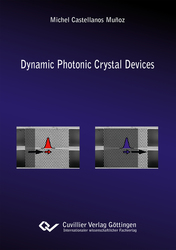| Departments | |
|---|---|
| Book Series (96) |
1378
|
| Nachhaltigkeit |
3
|
| Gesundheitswesen |
1
|
| Humanities |
2367
|
| Natural Sciences |
5406
|
| Mathematics | 229 |
| Informatics | 319 |
| Physics | 980 |
| Chemistry | 1363 |
| Geosciences | 131 |
| Human medicine | 243 |
| Stomatology | 10 |
| Veterinary medicine | 108 |
| Pharmacy | 147 |
| Biology | 835 |
| Biochemistry, molecular biology, gene technology | 121 |
| Biophysics | 25 |
| Domestic and nutritional science | 45 |
| Agricultural science | 1004 |
| Forest science | 201 |
| Horticultural science | 20 |
| Environmental research, ecology and landscape conservation | 148 |
| Engineering |
1793
|
| Common |
98
|
|
Leitlinien Unfallchirurgie
5. Auflage bestellen |
|
Advanced Search
Dynamic Photonic Crystal Devices (English shop)
Michel Castellanos Muñoz (Author)Preview
Table of Contents, Datei (83 KB)
Extract, PDF (85 KB)
Optical technologies constitute the core of long-haul communication. The large bandwidth and low propagation losses provided by fiber based optical communication systems make it possible to transport large amounts of information over long distances, for instance, between continents [1–3]. Beyond that, their superior performance is increasingly pushing the introduction of optical interconnects for communication over shorter ranges. In enterprise networks, for example, comprising distances up to a few kilometers, optical interconnects are deployed for applications requiring large bandwidth and propagation lenghts 3. Furthermore, as bandwidth requirements increase and the miniaturization of integrated electronics advances, the performance of electrical interconnects decreases even at the very short ranges (10 m) of board-to-board, chip-to-chip and on-chip communication [3–11]. At these integration levels, too, optical interconnects have been proposed to overcome the expected limitations [3–11].
| ISBN-13 (Hard Copy) | 9783954049493 |
| Final Book Format | A5 |
| Language | English |
| Page Number | 126 |
| Edition | 1. |
| Publication Place | Göttingen |
| Place of Dissertation | Hamburg |
| Publication Date | 2015-03-10 |
| General Categorization | Dissertation |
| Departments |
Physics
|








